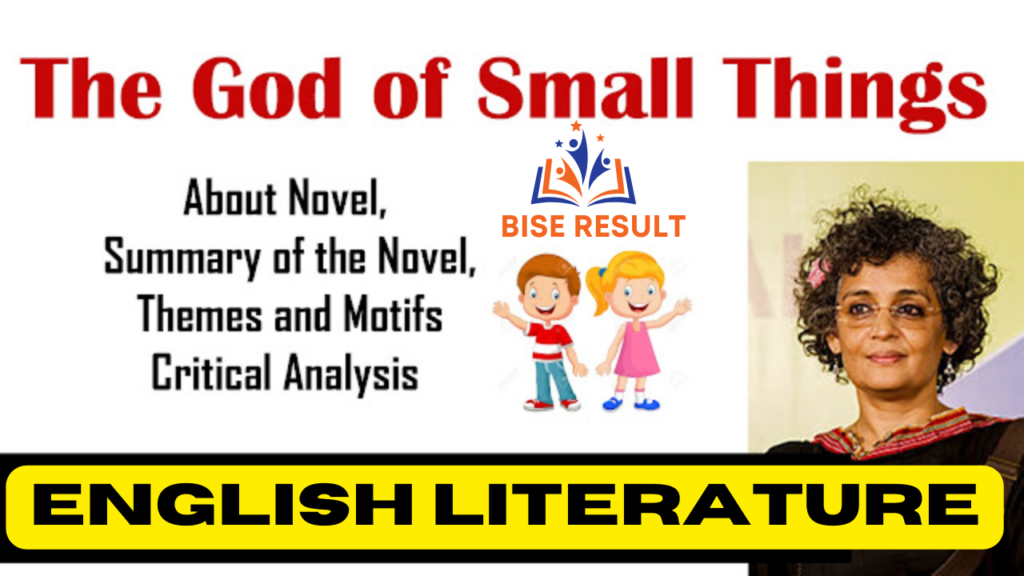Contents Of Article
ToggleThe God of small things summary
Journey into the Evocative World of “The God of Small Things” Arundhati Roy’s novel, The God of Small Things, is not merely a story; it’s an immersive journey. We are transported to the vibrant setting of Kerala, India, where we follow the lives of fraternal twins, Rahel and Estha. Their childhood innocence clashes with the harsh realities of social injustice and forbidden love. The God of small things summary.
This captivating narrative unfolds through a unique blend of past and present, offering a torrent of emotions – love, loss, rebellion, and the enduring power of memory.
However, The God of Small Things goes beyond a simple family drama. It delves into sensitive themes such as caste prejudice and the lasting impact of colonialism. Roy’s beautiful prose vividly depicts a bygone era while prompting discussions about enduring social constructs.
Are you ready to embark on a journey exploring themes of love, loss, and the enduring power of the past? Dive into The God of Small Things and discover a world where even the smallest moments hold immense significance.
Publication date
The novel “The God of Small Things” by Arundhati Roy was published in 1997. Although we don’t have an exact written date, we can infer that the manuscript was likely completed in the years leading up to publication. Roy started writing it in 1992 and finished four years later in 1996, making 1996 the probable year it was written. The God of small things summary.
Summary
“The God of Small Things” is a book by Arundhati Roy. It came out in 1997. The story is about two twins, Rahel and Estha, growing up in Kerala, India.
Their Childhood:
The story starts in 1993 when Rahel and Estha are adults. They’re not close anymore because of some bad things that happened. Then the story goes back to the 1960s when they were kids. They had a happy childhood until Velutha, a lower-caste worker, comes into their lives.
Forbidden Love and Problems:
Their mom, Ammu, falls in love with Velutha, but it’s against the rules because of their different castes. This causes big problems, and Ammu is treated badly by everyone.
A Big Tragedy:
Another bad thing happens when their cousin Sophie Mol dies. Rahel and Estha can’t handle it, so they’re sent to live with their strict grandmother.
The story switches between past and present. It shows how what happened in their childhood still affects them as adults. Rahel tries to move on, but Estha shuts himself off from the world.
Themes:
The book talks about important things like:
- Losing innocence: The twins’ happy childhood is ruined by bad events.
- Forbidden love: Ammu and Velutha’s love is not allowed because of the caste system.
- Caste system: The book shows how unfair and cruel the caste system can be.
- Memory and trauma: The past affects the twins’ lives in a big way.
- Family: Even though they’re not close anymore, Rahel and Estha still share a strong bond from their childhood.
The Writing:
Arundhati Roy’s writing is beautiful and describes Kerala well. She shows the feelings of love, loss, and anger really well.
“The God of Small Things” is a deep book that makes you think. It talks about love, loss, society’s rules, and how people keep going even when things are tough.

Conclusion
The ending of Arundhati Roy’s “The God of Small Things” is impactful, leaving readers with lingering thoughts about the characters’ fates and the themes explored. Here’s a detailed look:
Ammu’s Tragic End:
Ammu, rejected and heartbroken, dies alone at a young age. This news, revealed to Rahel later, shows the lasting pain caused by societal pressures.
Estha’s Emotional Isolation:
Estha remains emotionally distant, unable to connect fully with the world or even his sister. His silence reflects the lasting effects of childhood trauma and the struggle to move forward.
Rahel’s Uncertain Path:
Rahel, though scarred, tries to form a new connection with a man. This uncertain relationship offers a glimmer of hope, but its long-term success is left uncertain. The ending doesn’t confirm if she can break free from the past.
A Cycle of Loss:
The cyclical nature of the story shows that the characters are trapped in a cycle of loss and longing. The twins’ inability to escape their past trauma suggests the lasting impact of social injustice and family complexities.
Themes Revisited:
The conclusion reinforces the novel’s main themes:
- The Past’s Hold: The twins’ troubled present stems from their traumatic past.
- The Power of Memory: Memories continue to shape their lives, both good and bad.
- Resilience: Despite the tragedies, Rahel’s attempt at a new relationship hints at resilience.
Open-Ended Interpretation:
The ending doesn’t give clear answers, inviting readers to think about the characters’ fates and larger questions about love, loss, society, and healing.
A Haunting Image:
The final scene of the twins standing apart on the Ayemenem bridge leaves a lasting impression, evoking longing and tension. It prompts reflection on the book’s emotional impact and its exploration of social issues.
In summary, the ending of “The God of Small Things” doesn’t wrap up neatly but stays with readers, highlighting the lasting effects of the past, the power of memory, and the complexities of human relationships. Here is The God of small things summary.


Your point of view caught my eye and was very interesting. Thanks. I have a question for you.
Thanks for sharing. I read many of your blog posts, cool, your blog is very good.
Thank you for your sharing. I am worried that I lack creative ideas. It is your article that makes me full of hope. Thank you. But, I have a question, can you help me?